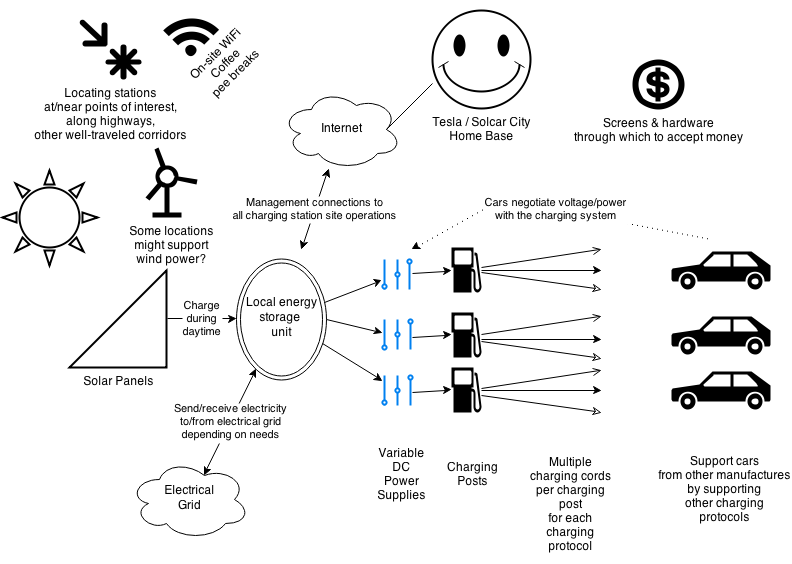At the intersection of smart grid services, on-site renewable energy generation, on-site grid energy storage, and electric cars, is the new energy energy model. I’ve recently written a few posts about the stone age energy model, where we burn things to create heat, motion or light. Most cars, trucks, etc are one way we are remaining stuck in the stone age model, by burning liquid fuels. Even electric vehicles keep us stuck in the stone age if the electricity comes from burning fossil fuels. Burning things, especially fossil fuels, causes many problems.
We want our electric cars to take part in the new energy model, rather than the stone age model. That’s why they’re often pictured next to wind turbines and solar panels. Above is an image I created a few months ago demonstrating one method of powering electric cars with properly renewable energy – the new energy model.
Let’s focus this picture on the key elements
What we’re looking at are electric car charging stations not connected directly to the grid, but indirectly through a grid-connected energy storage unit. That is, a large battery pack. There are several reasons for this, all of which are compelling:
- Eliminating the demand charges which plague fast charging installations
- Earning revenue on smart grid services – both demand response as well as sending energy into the grid
- Protection against blackout – cars can be refueled even if there’s a large scale power outage
- Erase the stigma of coal powered electric cars
- Serving a large number of electric cars without straining service panel capacity
The key is co-locating the grid energy storage unit (large battery pack) with the charging stations. That energy storage unit can be charged from the grid at a modest rate – one that’s low enough to not trigger demand charges – while charging the connected cars at a high rate.
There’s a huge potential to earn significant revenue from the grid energy services, and to benefit from the spread between night-time and day-time electricity rates. In many places there’s so much excess electricity at night that the cost goes negative (“dollar cost negative”) meaning the utility company is paying people to take that electricity. This might be enough that the charging networks could afford to give away charging services for free.
It’s been promised that electric car owners would be able to earn money by leaving their car connected to the grid full time. In the due course of time it may be that every parking space in every parking lot has electric car charging service. A question would be – what would motivate every parking lot owner, and every car owner, to build that infrastructure and to ensure their car is constantly connected to the charging infrastructure? Is there enough money earning potential from smart grid energy services to make it worthwhile? We don’t know yet, but let’s think about a few things which can be done.
Demand charges are levied by some utility rate plans on intermittent high-load services. For example, the person who pulls up to a DC Fast Charging station and plugs in their car – they’re suddenly pulling 50 kilowatts from the grid. The utility providers have to quickly switch gears or pull levers or something to handle that sudden demand spike.
The demand response service is the flip side of demand charges – because it’s the demand response providers who often provide the capacity to handle demand spikes. That signal is sent by grid operators to cooperating partner organizations when there load on the grid (the demand) is momentarily too high, and needs to be lowered. Typically a company will respond to demand response signals by turning air conditioner or refrigeration or lighting units to a lower setting (or off) momentarily. Responding to such signals can earn quite a few dollars.
An electric car charging station operator can perform demand response by adjusting the charging rate for electric cars. The charging rate adjustment is simple to implement by sending a command signal through the charging interface to the car.
But in this picture it’s not the car that’s connected to the grid, but the energy storage unit. Whether that unit is pulling power from the grid depends on the storage unit’s size relative to how frequently it’s used to recharge electric cars. The storage unit need not be big enough for a full day of electric car charging w/o pulling power from the grid. It just needs to be big enough to avoid a large demand spike.
That means the on-site storage unit will probably be charging most of the day from the grid, unless there are also on-site solar panels. This means demand response revenue can be earned from the on-site energy storage unit. If there is excess energy, say from on-site solar or on-site wind generation, that energy could be sold into the grid to earn additional revenue.
What’s meant by “without straining service panel capacity” is a situation in many public or workplace charging situations. Parking garages typically aren’t provisioned with huge electricity supply circuits. Instead, in most cases, the electricity service is either nonexistent or just enough for the overhead lights. Since we’re going to be adopting electric vehicles in large numbers within a few years – how will there be enough electricity supply in parking lots when the vast majority of parking lots have inadequate electricity?
That brings us to the back room filled with grey electricity service boxes. What happens there is crucial to the success of this project of getting electric vehicles adopted everywhere.
The current rule is that each charging station is assigned to one circuit in the service panel. The calculation is simple – multiply the amps per circuit (typically 40 amp capacity) by the number of charging stations, and that’s the size of the required service panel. It’s relatively cheap to increase number of charging stations until you hit the limit imposed by the service panel capacity. Upgrading the service panel is relatively expensive, an amount the parking lot manager is unlikely to pay.
What if power could be apportioned out to the charging stations, allowing there to be more charging stations than indicated by the service panel capacity? A controlling unit would be required that can adjust the charging rate as needed to avoid overloading the service panel. For example, with a 1000 amp service panel and 100 electric cars connected to charging stations, each car could be adjusted to charge at 10 amps, 50 cars adjusted to charge at 20 amps, and so on.
In March, Honda showed off a house implementing a small form of this idea – which they’re using as a research lab to study the intersection of smart grid, photovoltaics and electric cars. Everything is sized for the needs of one house, and one or two electric cars. The house has a solar electricity system on the roof, a grid energy storage system in the garage, and uses CHAdeMO for DC charging the car. Everything in the system is DC power to avoid conversion losses.
Last weekend Valery Miftakhov, CEO of Electric Motor Werks, presented to the EAA Silicon Valley chapter over a project implementing just the demand response portion of this model. EMW is part of a pilot project in California combining smart grid services with electric car charging stations. Participants get a free charging station, and EMW will act as a “demand response aggregator” earning its revenue from responding to “demand response” signals.
Miftakhov suggested to us that when there are a significant number of electric cars (1 million? 2 million? etc) that, summing together all their battery packs, would be an energy storage capacity equating to a huge chunk of the electricity running through the electrical grid. That fact represents a lot of power, not only electrical power, but economic power.
Demand Response is a small example of that power. That signal is sent by grid operators to cooperating partner organizations when there load on the grid (the demand) is momentarily too high, and needs to be lowered. Typically a company will respond to demand response signals by turning air conditioner or refrigeration or lighting units to a lower setting (or off) momentarily. Responding to such signals can earn quite a few dollars.
For better or for worse what motivates companies to do things is money, and earning profit.
The simple model (buy electricity, sell to customers) for electric car charging service might not offer enough revenue-earning potential to make a profit. But the picture above affords many more revenue earning opportunities.
The design can be scaled to any size from a single family home up to installations supporting thousands of cars.
- Highway design could decrease death and injury risk, if “we” chose smarter designs - March 28, 2015
- GM really did trademark “range anxiety”, only later to abandon that mark - March 25, 2015
- US Government releases new regulations on hydraulic fracturing, that some call “toothless” - March 20, 2015
- Tesla Motors magic pill to solve range anxiety doesn’t quite instill range confidence - March 19, 2015
- Update on Galena IL oil train – 21 cars involved, which were the supposedly safer CP1232 design - March 7, 2015
- Another oil bomb train – why are they shipping crude oil by train? – Symptoms of fossil fuel addiction - March 6, 2015
- Chevron relinquishes fracking in Romania, as part of broader pull-out from Eastern European fracking operations - February 22, 2015
- Answer anti- electric car articles with truth and pride – truth outshines all distortions - February 19, 2015
- Apple taking big risk on developing a car? Please, Apple, don’t go there! - February 16, 2015
- Toyota, Nissan, Honda working on Japanese fuel cell infrastructure for Japanese government - February 12, 2015





















Pingback: Elon Musk launches Tesla Energy – grid energy storage systems for homes and utility companies | The Long Tail Pipe